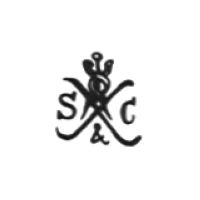
Image 010203-03-01
Used from 1896.
Originally from Angelroda (Thuringia) Christian Heinrich Schumann (*1822, †1884) had a small pottery in Arzberg that had to close because it was in the way of the railway which was finalized in November 1879 and connected Arzberg with the railway network.
Together with businessman Riess as financial backer, Christian Heinrich Schumann founded his new porcelain-orientated factory directly under the Jakobsburg castle, next to the market square in the town center and ironically directly next to the railway tracks responsible for the closure of his previous business. From the four children Christian Heinrich Schumann and his wife Christiana (*1838, †1928) had, only three made an impression on the further company history. Only the youngest child with the name of Carl (*1871, †1926) was really interested in the factory and business proceedings while the older son Christoph (*1864, †1916) helped out now and then but often started endless discussions on how a factory should be run. Third son Eduard on the other hand kept out of the way and rather concentrated on his studies.
In such a situation it was only understandable that shortly before Christian Heinrich Schumann passed away in 1884 he stated that Carl should inherit the factory as he not only showed most interest but had also more than once impressed his father with technical knowledge and the ability to quickly adapt to various situations. However Carl was not old enough to officially take over business when his father died and so the company was run by his mother Christiana.
The factory was renamed on the 21st birthday of Carl Schumann I, however his mother still remained in charge until she stepped down in 1896 when Carl married. Business steadily increased and so Carl as porcelain specialist together with his brother Eduard as manager launced a second business in 1904, the Westdeutsche Porzellanfabrik Duisdorf GmbH in Duisdorf near Bonn (North-Rhine Westphalia). Christoph Schumann had previously married into the wealthy land owners family Schreider in the town of Schwarzenhammer and in 1905 together with his father-in-law Karl August Schreider founded the Porzellanfabrik Schumann & Schreider there.
Years passed and business steadily increased, allowing the company to build a library and a canteen for their workers next to providing cheap housing for employees that originally had lived further away. Due to his social engagement Carl Schumann I eventually became privy councillor in Arzberg and his two sons Heinrich and Carl Schumann II (*1898, †1975) were frequently seen in the factory, greedily absorbing knowledge.
On July 19th 1923 the company was transformed into a corporation and all seemed fine, but three years later Carl Schumann I died at the age of only 55. He was succeeded by his son Carl Schumann II who at the time had been studying in America and later founded the Schumann China Corporation of New York which distributed Schumann products in the U.S. up until the late 1920's. The factory was run by his brother Heinrich during his absence. While the new market in the U.S. at first seemed very promising, the world financial crisis which started in New York on October 25th 1929 put a dramatic end to nearly all Schumann export efforts. But the 'home front' was not much better and the relatively short-lived business in Duisdorf which had specialized on Zwiebelmuster ("Blue Onion") and Strohblume ("Strawflower") decorated items remained in family hands only until 1935 before it was sold due to economic reasons (see there).
It should be noted that the Carl Schumann company had quite interesting business relations with companies from U.S. and the factory was one of a few that produced items for Ebeling & Reuss which then were sold under the 'Erphila Germany' mark. Another little known fact is that the Carl Schumann Porzellanfabrik AG was one of the few German companies allowed to produce Mickey Mouse figurines under license from Disney. They used a beautiful add created by Zereiss & Co. to promote these porcelain products, featuring little Mickeys performing a traditional Bavarian dance. Most of these so-called 'un-aryan' products were destroyed during the Third Reich period from 1934 to 1945 and are therefore among the rarest European pre-war Disneyana collectibles.
Following WW2 the company supported many former Sudeten Germans by offering housing and employment and after founding the house building company Schumann-Wohnungsbau GmbH in 1950 eventually tried to match former success, reaching its maximum number of 1053 workers and 70 salaried employees in 1953/1954. At that time the factory used three round kilns as well as three complete tunnel kilns as lots of items were needed for the local market but at the same time export numbers stagnated as more and more cheap imports from Japan were flooding the U.S. market and slowly pushing European and especially German items aside. Carl Schumann II resigned in 1961, leaving the business to his son Carl Schumann III before dying in 1975 and having in the meantime been town mayor and declared freeman of Arzberg.
Carl Schumann III during the next few years started the modernization and rationalization of the factory and drastically restructured and downsized the product range. These steps resulted in a much smaller workforce required to run the factory (merely 350 people) but business still steadily declined. The granddaughter of Carl Schumann I, business graduate Sabine Schaefer, finally took over as manager in 1981 and greatly improved business relationships not only in Germany but also in Europe and the USA. A few years later however, German reunification caused drastic changes as former state-owned and then privatized East German companies all fought for shares on the German market.
The Schumann company in 1990 joined a strategic alliance with Gebrüder Frank GmbH & Co. KG who owned the Sächsisches Porzellanwerk Freiberg as well as the porcelain factory in Colditz. But many misjudgements concerning the market development both in Germany and overseas got the manufacturers involved into financial trouble, forcing them to disband. Facing bankruptcy like so many others at the same time and not standing a chance of finding investors, the Schumann factory closed down in 1994.
The pictures marked with (Picture: Sharon Dickinson) are rescaled versions of pictures personally taken by Sharon Dickinson for her site www.efineantiques.com and are used here with kind permission. All rights reserved by Sharon Dickinson.

Image 010203-03-01
Used from 1896.
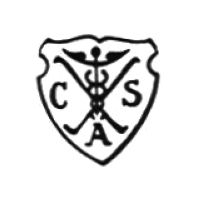
Image 010203-03-02
Used from 1897.
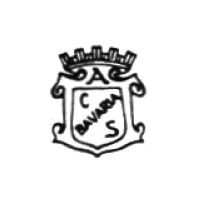
Image 010203-03-03
Used after 1900.
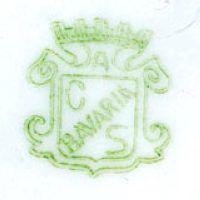
Image 010203-03-04
Used after 1900, green version.
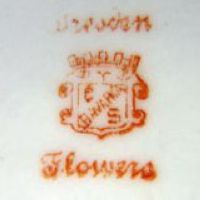
Image 010203-03-05
Used after 1900, red version with "Dresden Flowers" addition.
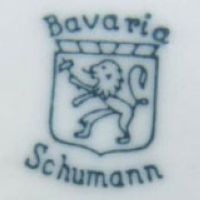
Image 010203-04-01
Used between 1918 and 1929. Registered late (and without additions) at the RWZR under registration №·349·861 on March 26th 1926 ...
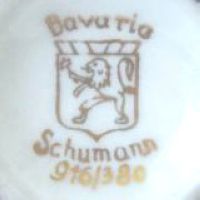
Image 010203-04-02
... and under №·359·336 on April 8th 1926 (including "Bavaria" and "Schumann" additions).
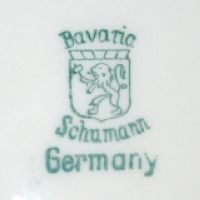
Image 010203-04-03
"Bavaria, Schumann" and stamped "Germany", used between 1918 and 1929.
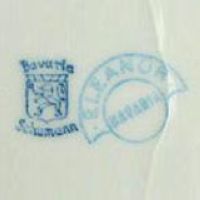
Image 010203-04-04
Used between 1918 and 1929, here one with an "Eleanor Bavaria" mark.
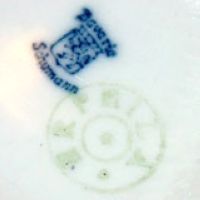
Image 010203-04-05
Used between 1918 and 1929, here one with an ERPHILA mark.
(Picture: Bruce G. Hoffman)
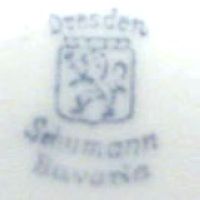
Image 010203-04-07
"Dresden, Schumann, Bavaria", used between 1918 and 1929.
(Sharon Dickinson)
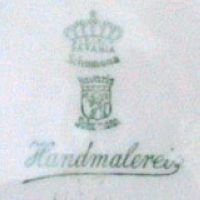
Image 010203-04-08
Used between 1918 and 1929, here in combination with the single "Schumann" crown and Handmalerei addition.
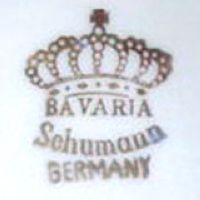
Image 010203-04-09
Used between 1918 and 1929, single "Schumann" crown which was also used without "Schumann" or with "Bavaria" instead of "Germany".
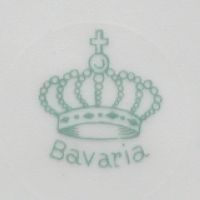
Image 010203-04-10
Used between 1918 and 1929, single "Schumann" crown with "Bavaria". Modern-looking version normally found in either green ...
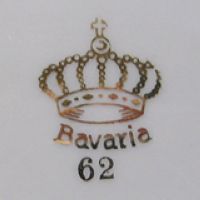
Image 010203-04-11
... or gold.
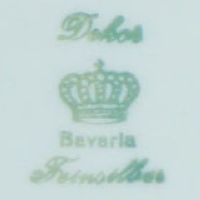
Image 010203-04-12
Used between 1918 and 1929, single "Schumann" crown with "Bavaria" and "Dekor Feinsilber".
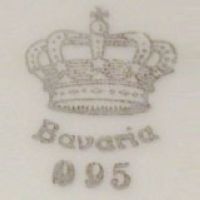
Image 010203-04-13
Used between 1918 and 1929, single "Schumann" crown with "Bavaria".
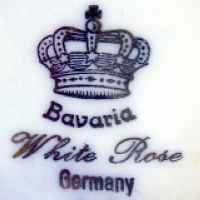
Image 010203-04-14
Used between 1918 and 1929, single "Schumann" crown with "Bavaria" above "White Rose" series name and "Germany".
(Picture: Eduardo Ugalde)
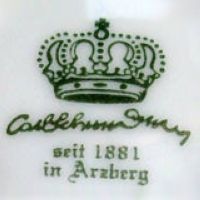
Image 010203-04-15
Introduced in 1931 as 50 year anniversary mark and used until around 1940, "seit 1881 in Arzberg" and Carl Schumann signature.
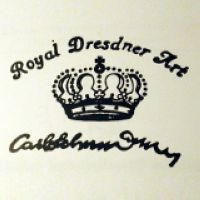
Image 010203-04-16
Same basic mark as before but with "Royal Dresdner Art" addition above the crown.
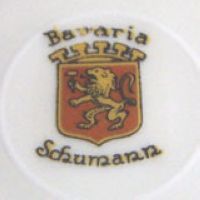
Image 010203-04-17
Used from 1932 onwards, also seen with additional "Germany".
(Picture: Sharon Dickinson)
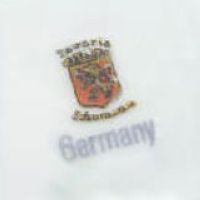
Image 010203-04-18
Used from 1932, this one shows the previously mentioned "Germany" addition.
(Picture: Sharon Dickinson)
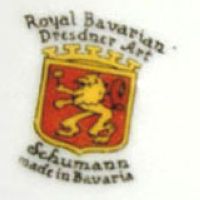
Image 010203-04-19
Used from 1932 until 1940, "Royal Bavarian" above "Dresdner Art", "Schumann" and "Made in Bavaria".
(Picture: Sharon Dickinson)
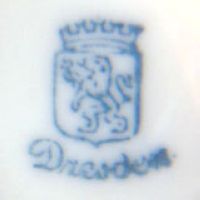
Image 010203-04-20
Used between 1932 and 1944.
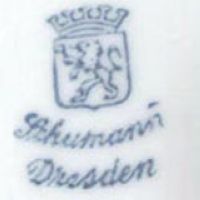
Image 010203-04-21
Used between 1932 and 1944.
(Picture: Sharon Dickinson)
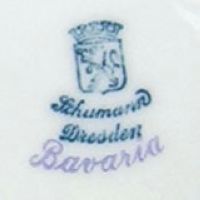
Image 010203-04-22
Used between 1932 and 1944, with additionally stamped "Bavaria".
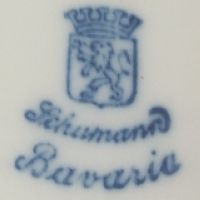
Image 010203-04-23
Used between 1932 and 1944, without "Dresden" but with included "Bavaria".
(Picture: forumuuu.com)
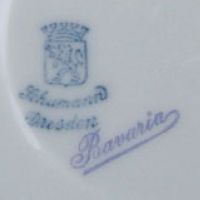
Image 010203-04-24
Used between 1932 and 1944, another example with additionally stamped "Bavaria".
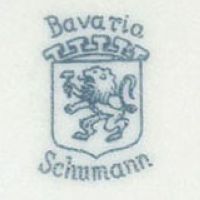
Image 010203-04-25
Used around 1945, blue version.
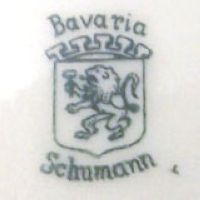
Image 010203-04-26
Used around 1945, near black version.
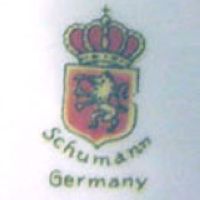
Image 010203-04-27
Used around 1945.
(Picture: Sharon Dickinson)
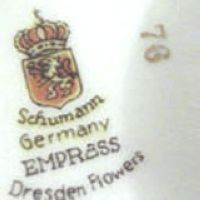
Image 010203-04-28
Used around 1945.
(Picture: Sharon Dickinson)
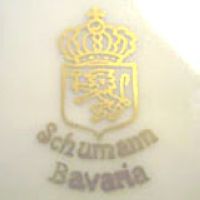
Image 010203-04-29
Gold over glaze, used around 1945.
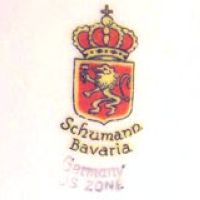
Image 010203-04-30
Used between 1946 and 1949, with extra applied "Germany, US Zone".
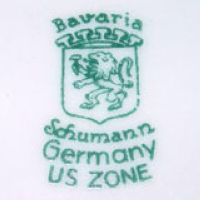
Image 010203-04-31
Used between 1946 and 1949.
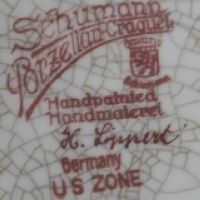
Image 010203-04-32
Used between 1946 and 1949, special "Porzellan-Craquel" marking including H. Lippert decorator signature.
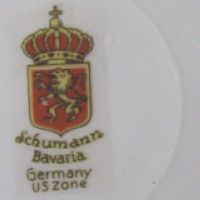
Image 010203-04-33
Used between 1946 and 1949.
(Picture: Kate Potter)
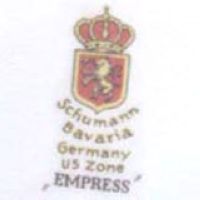
Image 010203-04-34
Used between 1946 and 1949.
(Picture: Sharon Dickinson)
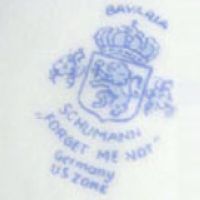
Image 010203-04-35
Used between 1946 and 1949.
(Picture: Sharon Dickinson)
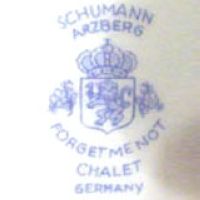
Image 010203-04-36
Used between 1950 and 1960.
(Picture: Sharon Dickinson)
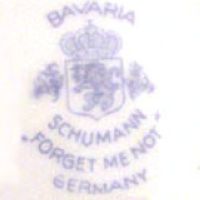
Image 010203-04-37
Used between 1950 and 1960.
(Picture: Sharon Dickinson)
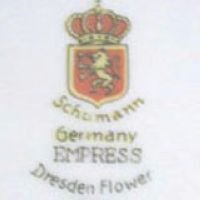
Image 010203-04-38
Used from 1955, here on the "Empress / Dresden Flower" series.
(Picture: Sharon Dickinson)
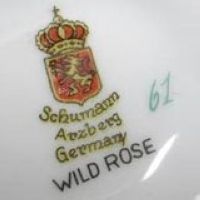
Image 010203-04-39
Used from 1955, here on the "Wild Rose" series.
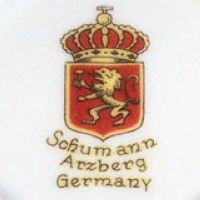
Image 010203-04-40
Used from 1955, with "Schumann" and "Arzberg".
(Picture: Susanne Veith)
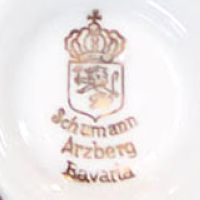
Image 010203-04-41
Used from 1955, golden version.
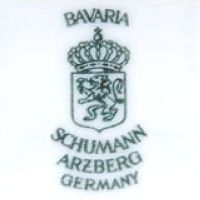
Image 010203-04-42
Used between 1960 and 1970, this time in dark blue.
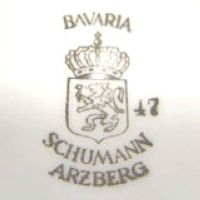
Image 010203-04-43
Used between 1960 and 1970. Note that some versions do not show "Germany".
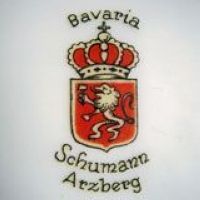
Image 010203-04-44
Used between 1960 and 1970, topped with "Bavaria" and with "Schumann" above "Arzberg".
(Picture: Susanne Veith)
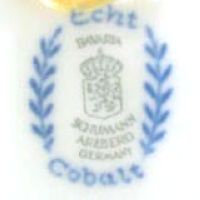
Image 010203-04-45
Used between 1960 and 1970 for cobalt-decorated pieces.
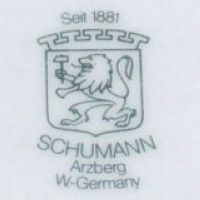
Image 010203-04-46
Used after 1981, commemorating the 100 year anniversary of the Christoph, later Carl Schumann period. Note the early "W.-Germany".
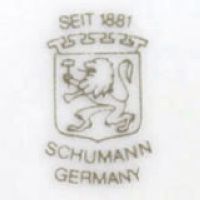
Image 010203-04-47
Used after 1981, same as before only with a plain "Germany" again.
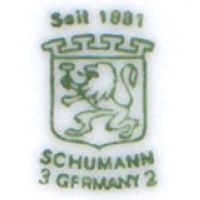
Image 010203-04-48
Used after 1981, same as before, this time with numbers left and right of "Germany".
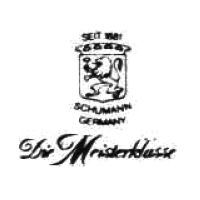
Image 010203-04-49
Used after 1981, "Seit 1881" over crown and shield over "Schumann" over "Germany" over "Die Meisterklasse", gold under glaze.
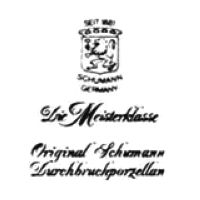
Image 010203-04-50
Used after 1981, same as before only carrying the addition "Original Schumann" over "Durchbruchporzellan", gold under glaze.
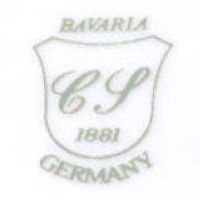
Image 010203-04-51
And finally a totally out-of-line mark only used on low-priced items for third parties.
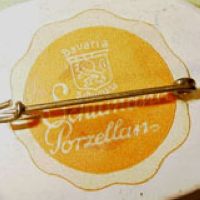
Image 010203-04-52
Here an example of the sticker used on porcelain pendants and brooches.
© 2004-2025 C.S.Marshall, all rights reserved